|
|
| |
SPAIN
MALAGA
Málaga is a city and a municipality in the Autonomous Community of Andalusia, Spain. It is also the southernmost largest city in Europe. It lies on the Costa del Sol of the Mediterranean Sea, about 100 km (62.14 mi) east of the Strait of Gibraltar and about 130 km (80.78 mi) north of Africa. It enjoys warm winters and hot summers lasting 8 months from April to November. Malaga is one of the oldest cities in Europe, it's history spans approximately 2,700 years.
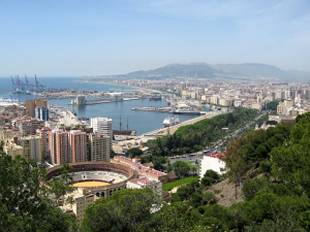 Málaga and its port
Photo: Olaf Tausch
Castillo de Gibralfaro and Alcazaba of Malaga
The Castillo de Gibralfaro and Alcazaba of Malaga are Moorish castles in Málaga, Spain. Built around the middle of the 11th century during the rule of King Badis, the Zirid ruler of Granada, to serve as the palace of the governors of the city. It is the best-preserved alcazaba in Spain. It is particularly intresting to see as they also give visitors panoramic views of the city and it's suburbs. The castillo can be reached via bus 35.
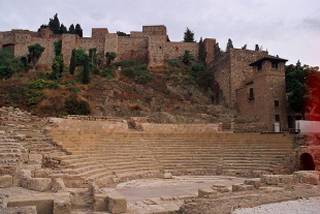 Alcazaba of Málaga
Málaga Cathedral
Cathedral of Málaga is Renaissance church in Málaga, Andalusia. It is located inside the limits that the missing Arab wall marked, forming a great architectonic set with the nearby Alcazaba and the Castle of Gibralfaro. It was constructed between 1528 and 1782, following the plans by Diego de Siloe. The interior of the cathedral is also in Renaissance style. Internally a series of artworks fills the temple, among them are the gothic altarpiece of the Chapel of Santa Barbara and the 16th century tombs of the Chapel of San Francisco.
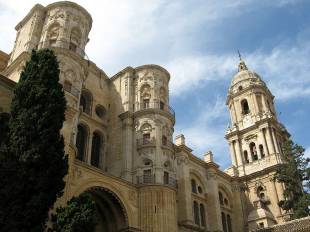
Málaga Cathedral
Photo: Olaf TauschMuseo Picasso Málaga
The Museo Picasso Málaga is a museum in Málaga, Andalusia, Spain, the city where artist Pablo Ruiz Picasso was born. in fact it is only 200 metres (660 ft) from the Plaza de La Merced, where Picasso was born. In the past the museum has had 155 works donated by members of Picasso's family. Besides its role displaying the work of Picasso, the museum has also committed itself to relaunch the city's cultural life, and to focus not only on tourism but on the local culture.
 Plaza de Toros de La Malagueta
Photo: Olaf TauschPlaza de Toros de La Malagueta
The Malagueta is the bullring in Málaga. It's located in the Malgueta next to Paseo de Reding. It was built in 1874 by Joaquín Rucoba was inaugurated on June 11 of 1876. Bullrings are often historic and culturally significant centres that bear many structural similarities to the Roman amphitheatre. The Malagueta ring takes the form of a hexadecágono (polygon of 16 sides) and has a capacity for 14,000 people. Every August it hosts the best bullfighters in Spain. It also holds a series of runs that coincide with the Malaga fair. Opening times: 10AM-1PM and 5-8PM, closed Saturdays, Sundays and Holidays. The Museo Taurino Antonio Ordoñez is a museum dedicated to the bullfighting. In the museum you can observe many objects relating to bullfighting, such as photographs of major bullfighters.
Botanical Gardens of Malaga
The Botanical Gardens of Malaga, called Los Jardines de La Concepción, consist of 25,000 sq.km. of beautifully landscaped grounds with 3,000 plant species set amongst fountains, streams and shady walk ways. The collection consists of species such as Moraces, Australian trees that stand out for their spurry trunks, and roots that hang from their branches and take root in the soil. The Chilean Palm is also notable as one of the four finest examples of its species in Spain. Chinese orange blossom, privet, young almeces, dwarf palms and south African species such as Bird of Paradise are also to be found. In addition, there is the dwarf date, which is one of the most elegant examples from South East Asia. There are guided visits available and special prices for children.
 Los Jardines de La Concepción
The MIMMA (Museo Interactivo de la Música de Málaga - Malaga Interactive Music Museum) houses one of the most comprehensive private collections in Europe, with over 300 instruments from different periods, countries and civilisations. The MIMMA is an extremely participative (interactive) museum, as well as a centre for activities and dissemination for everything related to the world of music. The MIMMA museum project is the only one of its kind in Europe, due both to its scope and the variety of its exhibits. It is conceived as a grand cultural space where visitors are surrounded by sound to stimulate their senses. It has a valuable collection of musical instruments from all over the world and is equipped with the latest technology for musical dissemination.
Rock Climbing
There is lots of great rock climbing in and around Malaga. The amazing El Chorro gorge is 50 minutes drive to the North West and this also features the 'Kings Walkway' - an amazing pathway suspended high above the gorge. There is also Via Ferrata and rock climbing at El Torcal near Antequerra.
Beaches
The nearest beach to the centre is La Malagueta - this is fine for a day's sunbathing although quieter and prettier beaches can be found further east. It can be a nice (if rather long!) walk along the waterfront to reach these beaches, otherwise you could get a bus from near the bull ring in the direction of El Palo (e.g. line 33).
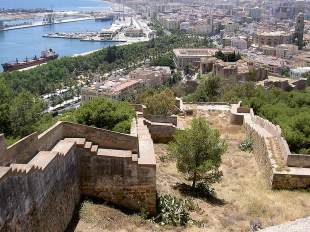 View of Málaga from Gribralfaro hill.
The walls of Gibralfaro castle are also visible.
Photo: manuelfloresv
Gibralfaro is an ancient fortress on mount of 131 meters, located in Málaga in southeast Spain. It dates back to the time when the Phoenicians founded the present city of Malaga. At the beginning of the14th century, Yusuf I of the Kingdom of Granada constructed Gibralfaro Castle, on an old Phoenician enclosure. The name is derived from the Phoenician word for light, Jbel-Faro, meaning "Rock of Light". The castle overlooks the modern city of Málaga and the Mediterranean Sea.
|
|
|
Festivals & Events
Seville Fair
The Feria de abril de Sevilla, literally Seville April Fair, is held
in the Andalusian capital of Seville, Spain. The fair generally begins
two weeks after the Semana Santa, or Easter Holy Week. The fair
officially begins at midnight on Monday, and runs six days, ending on
the following Sunday. Each day the fiesta begins with the parade of
carriages and riders, at midday, carrying Seville's leading citizens
which make their way to the bullring, La Real Maestranza, where the
bullfighters and breeders meet.
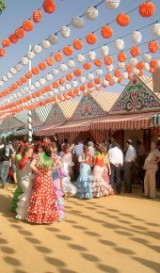 Casetas at Seville Fair
Photo: EdTarwinski
San Fermín
The festival of San Fermín is renowned for it's celebratory
tradition and is held in Pamplona anually on the 6th July. It is known
locally as Sanfermines and is held in honour of Saint Fermin. This
festival is important in terms of Spanish folklore and tradition. The
week long fiesta is most famous for it's encierro (running of the
bulls). It is belived that a million people flock to see this event
every year. The opening of the fiesta is marked by setting off the
pyrotechnic chupinazo. The rocket is launched at 12:00 noon on the 6th
of July from a city hall balcony with thousands of people celebrating
the act in the city hall square and other locations in Pamplona.
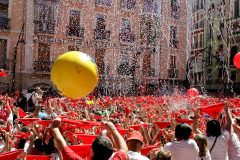 San Fermín Festival seen from
the Town Hall in Pamplona
Photo: Viajar24h
Fiestas del Pilar
Fiestas del Pilar is a large festival that takes place in Zaragoza,
Spain. This festival is religiously rooted in Spain and based on the
belief that Virgin Mary appeared to Saint James standing on a pillar.
The celebration lasts for seven days during which the city is bustling
with energy as over two million people visit the city for this fiesta.
Every day at 8 o'clock in the morning there is an event called
vaquillas, that is amateur bullfighting in the towns bullfighting ring,
or Plaza de toros. Everyone who is brave enough, can participate in this
event, in which many people get injured every year. The most important
celebration takes place on the 12th October, "The offering of flowers"
to the Virgin, who is removed from the Basilica and exhibited in a
platform placed on the square where the temple lies. The Offering of
Flowers is one of the more famous festive symbols of Spain.
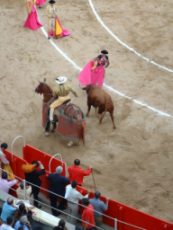 San Fermín Festival seen from
Bull running in Barcelona
Photo: BPG
Carnival
Carnival is a festive season which occurs immediately before Lent;
the main events are usually during February. Carnival typically involves
a public celebration or parade combining some elements of a circus,
mask and public street party. The Santa Cruz de Tenerifeand Las Palmas
de Gran Canaria is together with the Carnival of Cadiz, the most
important festival for Spanish tourism and Spain's largest carnival. In
Catalonia people dress up and organise parties for a week but
particularly on the weekend. Despite it being winter, parties are open
air, beginning with a cercavila to call everybody to come. Rues of
people dance along the streets. On Thursday Dijous Gras is celebrated,
also called 'the omelette day' and omelettes are eaten. Parties end by
burning Mr. Carnestoltes and with enterrament de la sardina (sardine's
funeral). Carnaval de Solsona takes place in Solsona, Lleida in central
Catalonia. It is one of the longest carnivals in Catalonia; free events
in the streets, and concerts every night, run for more than a week.
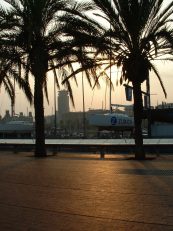 Barcelona harbour
Photo: BPG
Festival Internacional de Benicàssim
The Festival Internacional de Benicàssim is an annual music festival
sponsored by a well known beer label which takes place in the village of
Benicàssim, province of Castelló, Valencian Community in Spain. It
focuses mainly on pop, rock and electronica artists, as well as having
other elements besides music like short films, theatre, fashion and art.
Since the first festival in 1995, some of the most notable artists who
have played the festival include Paul Weller, Depeche Mode, Beck,
Radiohead, Kraftwerk, The Stone Roses, Brian Wilson, Blur, Lou Reed,
Oasis, The Chemical Brothers, Franz Ferdinand, The Killers, Morrissey,
Sigur Rós, Ride and The Strokes. As of 28 January, the line up for the
2011 Festival is as follows: Arcade Fire, Arctic Monkeys, Mumford &
Sons, Portishead, The Strokes, Beirut, Catpeople, Elbow, Friendly Fires,
Julieta Venegas, Lori Meyers, Primal Scream (present Screamadelica),
The Streets, Tinie Tempah, The Coronas, Grupo Salvaje, The Marzipan Man
Smile, Veronica Falls, Paolo Nutini, Pendulum, Mahmiri Acar. 'FIB' is
held in the seaside resort of Benicassim (Castellón province) on Costa
del Azahar, Valencia, Spain, 92.2 km away from Valencia Airport.
Festival goers who have purchased multi-day passes can camp for up to 9
days starting Monday before the festival starts and ending Tuesday after
the festival has ended. For more information please contact info@fiberfib.com
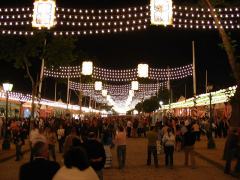
Festimad
Festimad is an alternative rock festival and cultural event held yearly
in Madrid, Spain since 1994, usually in the last week of May. Festimad
includes several parallel cultural festivals such as Performa, Graffiti,
Universimad o Cinemad, although its central event continues to be the
music festival, standing alongside the Festival Internacional de
Benicàssim as Spain's main rock concert. For more information please
contact festimad@festimad.es
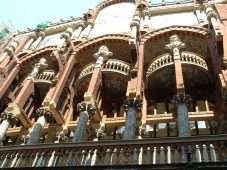 Photo: BPG
Bilbao Live Festival
The Bilbao Live Festival is a rock and pop music festival that takes
place in the summer in Bilbao, Spain since 2006. It is supported by BBK
the savings bank. Some 51,000 people attended the first edition of
Bilbao Live Festival in 2006, an event that reunited during three days
more than 40 national and international bands of rock and carps of
electronic music. Bilbao had thus burst in with force into the circuit
of great musical festivals of the summer time. The 2011 lineup includes
Coldplay, Blondie, Beady Eye, Crystal Castles, Russian Red, Ken Zazpi,
Amy Winehouse, Kasabian, Kaiser Chiefs, The Black Crowes, The Chemical
Brothers, Jack Johnson, 30 Seconds to Mars, M-Clan. For more information
please contact festivals@nme.com
|